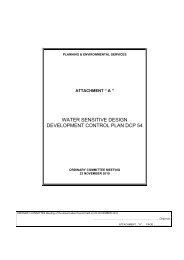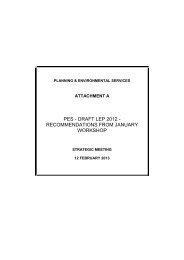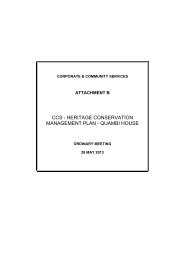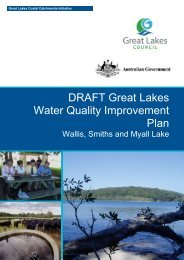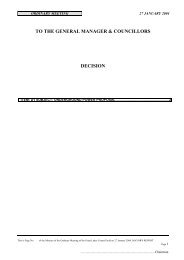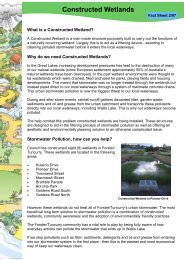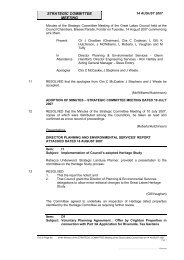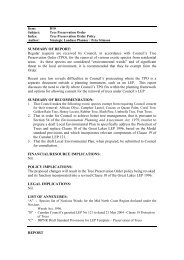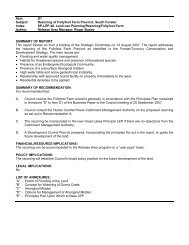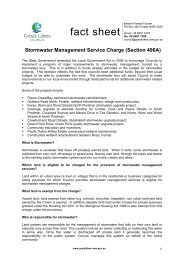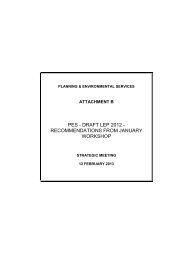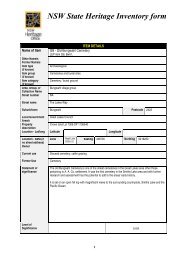13.2 The Wallis Lake Estuary Management Committee - Great Lakes ...
13.2 The Wallis Lake Estuary Management Committee - Great Lakes ...
13.2 The Wallis Lake Estuary Management Committee - Great Lakes ...
Create successful ePaper yourself
Turn your PDF publications into a flip-book with our unique Google optimized e-Paper software.
<strong>Wallis</strong> <strong>Lake</strong> <strong>Estuary</strong> <strong>Management</strong> Plan<br />
This study was conducted in response to the identification of nutrient and animal faecal pollution in areas of <strong>Wallis</strong><br />
<strong>Lake</strong> during the estuarine processes study (Webb, McKeown and Associates). In order for adequate management<br />
controls to be implemented addressing this issue more information was required on the sources and sinks of this<br />
pollution. This is typically a difficult task due to the physical processes of tides and run-off as well as other climatic<br />
and biological factors contributing to the complex movement of pollutants once they have entered the estuarine<br />
environment.<br />
Lipid biomarkers and pollen analysis were used in this study as tracers of nutrient and faecal pollution. Lipid<br />
biomarkers are of biological origin and can be very specific to groups of organisms such as types of phytoplankton<br />
or terrestrial plants. In addition to this certain biomarkers can be used to assess the source and degree of faecal<br />
contamination.<br />
Different types of pollen can be visually distinctive, and can therefore be traced back to the parent plant or plant<br />
communities. This allows an indication of various sediment sources and sedimentation rates within <strong>Wallis</strong> <strong>Lake</strong>.<br />
<strong>The</strong> composition of lipid biomarkers and pollen in sediment samples at potential end members of rural and urban<br />
inputs was assessed. <strong>The</strong> lipid biomarkers and pollen composition was found to be indicative of certain catchments,<br />
thus allowing the input of organic matter into the <strong>Lake</strong> from these areas to be mapped.<br />
No evidence of faecal input was found at any of the sites surveyed. However, herbivore faecal contamination was<br />
detected in sediments at the end member sites of the Wallamba and Coolongolook/Wang Wauk Rivers.<br />
This study identified a number of indicators that can be used to monitor faecal contamination in sediments and<br />
sedimentation rates. <strong>The</strong>se indicators will prove to be very useful when assessing any potential benefits from<br />
implementation of estuary and catchment management programs for erosion or nutrient/faecal pollution control.<br />
13.1.14 Benthic nutrient fluxes in <strong>Wallis</strong> <strong>Lake</strong> – Chief Investigators: Smith C. S., Heggie D. T.,<br />
Fredericks D. J., Palmer D. W. and Logan G. A. (2000 and 2003)<br />
Benthic nutrient fluxes are a measure of the transport of nutrients between the bottom sediments and the overlying<br />
water column. By quantifying these transports we can calculate the denitrification efficiency of benthic sediments.<br />
Denitrification is an important natural way for estuaries to cleanse themselves of excess nitrogen. It is a process by<br />
which nitrogen from plant organic material is converted to nitrogen gas by denitrifying bacteria and lost to the<br />
atmosphere. If this process is not operating efficiently, the organic nitrogen is instead converted to dissolved<br />
inorganic forms (nitrate, nitrite and ammonia) and is available for plant growth.<br />
If the dissolved inorganic nitrogen concentration exceeds the assimilative capacity of the system, eutrophication can<br />
occur. Eutrophication is a process of excess plant growth resulting in algal blooms, particularly of phytoplankton and<br />
free floating macroalgae. This is particularly detrimental to seagrasses, which can then be out-competed due to<br />
shading.<br />
<strong>The</strong>refore by measuring the benthic nutrient fluxes of <strong>Wallis</strong> <strong>Lake</strong> sediments assessments can be made on the<br />
trophic state of the water body and risk of eutrophication at specific study sites.<br />
125




